The ordinance of communion and receiving the Holy Eucharist are some of the most blessed pillars of the Catholic faith. Catholics can come together during communion and take part in the presence of Jesus Christ by consuming His body and blood, which were broken and spilled for our sins when He died on the cross for us. But as time passes, we can make sure we understand the true weight and beauty behind these practices.
Having a deeper Holy Eucharist background can help you enjoy a fuller understanding of this sacred practice, and thus deepen your faith. The information here will help familiarize you with the history of the Eucharist so you can better know why we still take part in this practice after all these years.
The Biblical Origins of the Eucharist
The Bible is the foundation of the Catholic faith. Within the Bible’s pages are historical accounts, stories, life lessons, teachings, instructions, commands and so much more that help guide our everyday lives. In the Bible, we learn how to have a relationship with God through Jesus Christ. We also gain insight into the lifestyle that should go along with a healthy relationship with God, including participating in the Holy Eucharist.
Many of the practical parts of Catholicism appear in the New Testament, including the origin of the Eucharist. But the entire Bible is full of metaphors and symbolism that show how it was always God’s plan for us to participate in communion together and take part in the presence of Christ in the Eucharist. Items like bread, wine, lambs, fruit, food and drink are scattered throughout the Biblical narrative, containing a deeper meaning that can take us right to Christ every time.
Let’s take a closer look at instances in the Old and New Testaments that forge the Biblical origins of the Eucharist.
The Old Testament
While Jesus implemented the Eucharist toward the end of His earthly ministry in the New Testament, The Old Testament foreshadows this event and contains many references to the lamb, blood, bread, sacrifice and offerings. These are some well-known Old Testament events that alluded to and prepared the way for the Eucharist:
- The Tree of Life: The origins of the Tree of Life are in the Garden of Eden in the book of Genesis. Once Adam and Eve had eaten from the Tree of the Knowledge of Good and Evil, God forbade them to eat from the Tree of Life and banished them from the Garden. The Tree of Life points ahead to the cross of Christ, which provides eternal healing with its fruit — the broken body and spilled blood of Jesus.
- Isaac: The account of Abraham and his son Isaac in Genesis 22 is the first reference to God providing a lamb for a sacrifice. Here, the Lord tests Abraham’s faith by asking him to sacrifice Isaac on an altar. Abraham promises his son that God will provide the sacrificial sheep, which He does. This lamb is a foreshadowing of Jesus, Whom God sent to be the sacrificial lamb on the cross in the place of all humankind.
- The Passover lamb: When the descendants of Abraham and Isaac were slaves in Egypt, God sent His Angel of Death to free them. He commanded Moses in Exodus 12 to tell the people to kill an unblemished lamb and apply its blood to their doorposts and lintels to protect them from suffering the same fate as the Egyptians. They were then to consume all the lamb’s meat alongside unleavened bread. St. Paul later calls Jesus our paschal lamb Who has been sacrificed to protect us from eternal death.
In these three Old Testament examples, eating and sacrifice lead to healing and salvation. These are clear references to the Eucharist and the body of Christ, but they will make even more sense when you view them in light of the New Testament examples.
The New Testament
As you move into the New Testament, you’ll discover several examples that much more clearly discuss the Eucharist and the doctrines behind it. Here are some examples:
- The Lamb of God: In John 1:29, John the Baptist makes a clear connection between Jesus and the sacrificial lamb, calling Him the Lamb of God and proclaiming that He has come to absolve the sins of everyone on Earth. This ties Jesus to both the story of Isaac as well as the Passover lamb.
- Miracle of the Loaves: The Miracle of the Loaves occurs in Matthew 14:13-21. In this passage, Jesus feeds a massive crowd of hungry followers by multiplying five loaves and two fish. Before passing out the food, Jesus looks up to heaven, blesses the loaves and then breaks them. These are the same actions He would take before instituting the Eucharist at Passover before his arrest and crucifixion.
- True Food and True Drink: Jesus alluded to both the Eucharist and the power of His body during His ministry on Earth. He makes the powerful claim in John chapter 6 that He is the bread of life, saying that one must eat his flesh and drink his blood to achieve eternal life. He goes so far as to call his flesh true food and his blood true drink.
- Institution of the Eucharist: Jesus instituted the Eucharist on the night before He was arrested in Matthew 26. While He and the disciples ate the Passover meal together, Jesus gave them bread and a cup of wine, telling them they were His body and blood. He commanded them to consume these elements and to continue to do so in memory of Him. Therefore, the Eucharist is the way to both remember Jesus’s sacrifice and participate in the body of Christ.
- The instruction of the Apostle Paul: After Jesus’s death and resurrection, the apostles continued to take the Eucharist and instructed the early churches in this practice of remembering Christ. In 1 Corinthians 11, St. Paul gives instructions on the proper manner of participating in communion, showing that the Eucharist was to be a central part of the lives of believers when they gathered.
The Early Days of the Church
The Eucharist has changed a lot since the times of the Bible. In fact, there is no single origin point for the practice of the Eucharist as it appears in today’s worldwide Church. Rather, it is the result of many different practices coming together over time to create a uniform, accepted tradition of the Eucharist. In other words, time has shaped our interaction with the Eucharist, but Christ’s presence is the one element that has remained unchanged throughout history.
To begin understanding how the Eucharist has developed over time, we must start with the early days of the Church. Based on the passage in 1 Corinthians 11, we learn that the Eucharist was part of a meal and that the believers were to wait for one another before eating. This is highly different than the Eucharist of today, which involves only the wine and the Eucharistic host, the bread. We immediately see that today’s Eucharist is independent of this larger meal of the Church’s early days.
But Paul was clear in his writings that communion was so much more than a meal. The same passage shows Paul telling the Corinthian believers that they must avoid taking communion in an “unworthy” manner, like being drunk, gluttonous or ungenerous. Besides making sure everyone is present before beginning, Paul stressed that every believer was to examine themselves to avoid falling under God’s judgment. This has led Catholic leaders throughout history to ensure the Church is participating in the Eucharist in a holy, reverent, and worthy manner.
Developing Liturgy
As the Catholic Church began to grow in those early years, early church leaders saw the need to develop liturgy surrounding communion and the Eucharist. When churches involved small gatherings in people’s homes, sharing a meal made more sense. But with more people joining the faith with each passing decade, those meals would start phasing out on their own. This left believers wondering about the right way to receive the Holy Eucharist.
During the first two centuries of the Church, leaders relied on the Church’s earliest writings, including letters from the Apostle Peter and the Apostle Paul to inform their Eucharistic liturgy. During these years, there was a split from Jewish Christians, but their influence of singing, prayers, homily and chanting would continue in Eucharistic liturgy. This development is known as the Liturgy of the Word.
There was still great liturgical freedom regarding the Eucharist during these first few hundred years of the Church. For instance, church leaders could compose their own prayers for Eucharistic liturgy as they saw fit. But as more eloquent church leaders like Hippolytus became known, more people began adopting their prayers in their church’s liturgy, helping to pave the way for liturgic standardization.
Spreading Christianity
Shortly after the start of the 300s, Roman Emperor Constantine made a decree that legalized Christianity empire-wide. This led to several hundred years of rapidly increasing interest in Christianity, with many more people joining the faith. As a result, significant liturgical changes regarding the Holy Eucharist occurred, as well.
Here are some of the main changes that happened during the ensuing centuries:
- Latin became the official language of the liturgy since it was the common language used throughout the Roman Empire.
- Far fewer Christian gatherings happened in homes, and they moved first into basilicas and then into dedicated church buildings.
- The clergy expanded and started wearing special clothes.
- A need for standardization led to the creation of liturgical books, and the Latin Mass in Rome ultimately became the official standard.
- The belief that the consecrated host was too holy to be touched by laypeople arose, leading to the practice of the host being placed on the recipient’s tongue.
- The clergy began emphasizing the divinity of Christ present in the Eucharist, causing some Catholics to feel unworthy of participating in communion. This led to church legislation saying that communion should be received at least once per year by all Catholics.
Transubstantiation and the Feast of Corpus Christi
The 1200s brought about two of the most important topics regarding the Eucharist — transubstantiation and the Feast of Corpus Christi.
Thomas Aquinas’s writings on transubstantiation proved to be the most influential for Catholics, with words reverberating into our understanding of the miracle of the Eucharist even today.
Aquinas defined transubstantiation as the physical elements of the Eucharist literally transforming into the body or blood of Christ. This differed and continues to differ from modern Christian beliefs that the bread and wine are mere symbols of remembrance. According to the Catholic doctrine of transubstantiation, the elements literally become the body and blood of Christ.
Several decades after the establishment of the doctrine of transubstantiation, the Feast of Corpus Christi was held. While the early church reserved the adoration of Christ’s body and blood for communion and Eucharistic celebration, some church leaders wanted to extend adoration to other times including Mass. The Church decided to take the occasion even further in attempts to repair controversies that heretics had brought forth during this era, so they instituted the Feast of Corpus Christi, or the Feast of the Body of Christ.
Growing Popularity
As the years have passed since the 1200s, Eucharistic Adoration has grown in popularity among Catholics. Eucharistic Adoration gives faithful Catholics a chance to meditate and rest in the presence of Christ while extolling worship and honor upon Jesus for his death on the cross and resurrection three days later. As such an important part of the faith, it makes sense that its appeal would spread far and wide with the passing years.
This increased popularity has led to more changes that mostly make the act of Eucharistic Adoration more accessible to Catholics, wherever they are. Most parishes now offer various times throughout the week for Catholics to adore the Eucharist. Some parishes even offer Perpetual Adoration, which is when the Holy Eucharist is on display 24 hours per day, 7 days per week. This ensures more Catholics can participate in the presence of Christ, whatever their schedules.
The Eucharist of Today
This brings us to the present day. Today, a Eucharistic Revival is taking place in Catholic churches around the world. Church leaders are re-emphasizing the cornerstone of our Catholic faith — the true presence of Jesus Christ in the Eucharist. This is all to help Catholics reignite their faith and deepen their relationship with God, Jesus Christ and the Holy Spirit.
The Church aims to re-center itself on the true presence of Jesus with us in the Eucharist. Jesus is calling Catholics to be a light to the world, and the Eucharistic Revival that’s happening in the United States right now is your opportunity to get involved.
Take Part in the Eucharistic Revival
You can participate in the Eucharistic Revival by helping Catholic World Mission provide monstrances to churches in need around the world. The monstrance is a crucial part of Eucharistic adoration as it beautifully displays the Eucharistic host so the faithful can draw near to Christ’s presence in the Eucharist. To help spread the light of Christ, your donation can help provide that monstrance to a church that needs it so more Catholics can experience a deepened faith that Eucharistic adoration brings.
Every donation helps. We humbly ask that you give to help provide monstrances around the world today.






